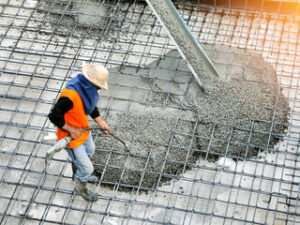Only three things are certain in life: death, taxes, and cracking concrete. This used to be a problem with stamped concrete, but improvements in techniques and materials have made it much less likely.

Stamped concrete is a decorative form of concrete that is textured and colored to imitate other materials. It is an affordable alternative to pavers and can create a unique look for your home.
Stamped concrete can be less expensive than other paving materials such as pavers or natural stone. It is also more durable than asphalt and requires less maintenance, as it does not need to be resealed. Additionally, stamped concrete can be installed without the need for rebar, making it an economical choice for large areas. In addition, stamped concrete is very easy to repair and replace if it becomes damaged. If you want to add a decorative touch to your home, you can choose from many different colors and patterns that match your landscape design.
The cost of stamped concrete will vary depending on your chosen pattern and color. However, you can find a contractor that will offer competitive rates. You should ask for a quote before hiring a contractor. Many contractors will also allow you to make a payment schedule based on fixed dates or project milestones. This will help you budget for your project.
While the concrete itself is relatively inexpensive, the cost of installing the stamps and coloring can quickly add up. In addition, the cost of labor is a significant factor in the overall price of stamped concrete. A professional concrete company will be able to provide you with an accurate quote for the job.
It is important to understand the cost of stamped concrete before you hire a contractor. The average cost is $8 to $12 per square foot, but this can vary significantly based on the complexity of the project and the amount of customization. If you want to create a more elaborate design, you should expect to pay more.
If you are considering using stamped concrete for your patio, driveway, walkway, or garden curbing, you should consult with several professionals to compare prices. It is also a good idea to book your project several months ahead of time, as this will help you avoid rush prices. In addition, you should consider asking the contractor about financing options.
Adding a decorative touch to your concrete surface can dramatically increase the curb appeal of your home and add value. It is important to consult with a professional contractor to ensure that the design you choose will look good and last long. It is also a good idea to choose a contractor with experience in the concrete industry.
Durable
Despite the common misconception that stamped concrete is less durable than pavers or natural stones, it can actually be more durable. This is because it is poured on-site and mixed according to specific specifications for strength and color. It is also a lot cheaper than other paving materials and requires less maintenance. For example, a stamped concrete patio needs only regular cleaning with a garden hose or pressure washer and some mild detergent. Additionally, it should be resealed every two to three years.
Stamped concrete can be used to make a patio, driveway, pool deck, or walkway. It is available in a wide variety of colors, patterns, and textures that can mimic the look of pavers, stone, tile, wood, or even textured concrete. It is a great way to add value to your home, and it is easy to install and maintain.
However, like any other type of paved surface, stamped concrete can crack over time. It is also prone to damage from freezing and thawing, which can cause unsightly expansion and contraction of the concrete. To prevent this from happening, it is important to use a high-quality sealant on your stamped concrete, and to have it resealed on a yearly basis.
One of the most popular uses for stamped concrete is to create a beautiful patio. This can be done in a backyard, around a pool, or even in a commercial setting. The options for design are endless, and the results can be stunning. However, it is important to hire a professional contractor for this type of project, as it is not recommended for do-it-yourselfers.
A well-designed stamped concrete patio can be a great place to relax or entertain guests, and it will last for years. It is also a smart investment for your home, as it will increase the value of your property. Additionally, stamped concrete is more affordable than other paving materials and can be installed quickly.
Unlike pre-cast systems, which have to be laid in strict sequence, stamped concrete can be placed on expansive soils and other challenging conditions. In addition, it is very easy to repair if damaged. This makes it a good choice for areas that experience heavy traffic and frequent weather changes.
Easy to maintain
Concrete is one of the most durable materials in existence, and when paired with high-quality stamps and colorant, it’s also one of the easiest decorative flooring options to maintain. However, it’s not without its drawbacks. Like any material, it can crack or become damaged if improperly installed or exposed to harsh weather conditions. This is why it’s important to work with a contractor who has years of experience and understands the proper construction and maintenance techniques to ensure your finished product looks great and lasts for decades.
To help your stamped concrete surfaces retain their beauty and durability, you’ll need to regularly clean them. This can be as easy as sweeping and hosing off the surface, or you may need to use a power washer on a low setting. Either way, it’s a good idea to avoid using abrasive cleaners or acidic products, as these can damage the finish.
For most areas, a mixture of warm water and mild soap should be sufficient to remove most stains. Depending on the severity, you may need to scrub with a brush or broom. In any case, you should always rinse the surface after cleaning. In addition, try to prevent debris from building up on the surface, as this can cause stains and increase moisture build-up. This is especially true in areas that receive deicing salts and ice melts, as they can quickly damage the surface.
Another way to protect your concrete and keep it looking its best is by applying a protective sealer. This will prevent dirt, chemicals, oil, and other substances from penetrating the surface, making it much easier to clean. Most contractors recommend resealing every two to five years.
Although stamped concrete is relatively easy to maintain, it’s still a good idea to hire a professional for the installation. This is because the process requires advanced skills and specialized tools that many DIYers do not have. In addition, if the project is not done correctly, it can result in costly repairs and a loss of visual appeal. To avoid this, you should always look for a professional contractor that has years of experience in concrete laying and has plenty of satisfied customers.
Versatile
The beauty of Stamped Concrete is that it can be molded and colored to mimic other materials like tile, stone, wood or brick. It also allows for unique designs that can easily add a touch of style to any home. It is one of the most versatile construction materials in terms of design, and it is often used for paving surfaces such as walkways, patios, and driveways. It is extremely durable and can withstand heavy loads without bending or breaking. In addition, it is less expensive than other paving material options and requires minimal maintenance over the years.
The key to creating the perfect stamped concrete is utilizing the right mix of materials, tools and techniques. Liquid coloring can be added directly to the concrete mixture before pouring, or it can be applied after the concrete has been poured and prior to stamping. Once the concrete has been poured and stamped, it is a good idea to tamp it down to eliminate any bubbles or unevenness.
Once the concrete has cured, it is important to apply a sealant to prevent it from becoming chipped or stained. A high-quality sealant will protect the concrete from weathering and fading, and it will keep the surface looking brand new for years to come. This is a great way to protect your investment and make sure that your concrete looks its best.
A popular use of stamped concrete is in outdoor paving applications, such as patios, driveways, and pool decks. It is an affordable alternative to other paving materials, such as pavers, and can create a beautiful, functional space in your backyard. It is also very easy to maintain and can withstand a lot of wear and tear.
Stamped concrete is also an excellent choice for driveways, as it can be poured in a variety of shapes and sizes. This can be especially beneficial for homeowners who want to replace their old, worn asphalt or concrete driveways with something more modern and stylish. The process of laying stamped concrete for a driveway is relatively quick, and it can be completed in just one day. Once the concrete is poured, it will need to cure for several days before being ready for use.


